Methods of Assessing the Damage Capacity of Input Seismic Motions for Underground Structures
Abstract
1. Introduction
2. Numerical Model of Soil–Underground Station System
3. Seismic Waves and Selection of the Severest Parameter
3.1. Seismic Wave Selection
3.2. The Severest Parameters
4. Result Analysis
4.1. Distribution Pattern of Structural Response
4.2. Correlation between the Severest Parameters and Structural Response under Different Intensities
4.3. Correlation between the Severest Parameters and Structural Response at Different Sites
4.4. Ranking of Seismic Damage Capacity
5. Conclusions
- (1)
- As the seismic intensity increases, the structural forces show an increasing trend. The range of the maximum inter-layer drift angle of the underground structure grows from 0.137% to 0.630% when the PGV increases from 10 cm/s to 120 cm/s, and the difference in structural response significantly increases. This indicates that it is necessary to differentiate the damage capacities of different seismic motions for structures under strong seismic conditions.
- (2)
- With a high PGV amplitude of the input seismic motions, the severest parameters exhibit a high correlation with structural responses under both near-field and far-field seismic motions, with the maximum correlation coefficient exceeding 0.9. The correlation with structural responses under ordinary earthquake conditions is poor, with a maximum correlation coefficient below 0.5. Therefore, the application of the severest parameters for ranking damage capacities for different seismic motions is more suitable for near-field and far-field seismic conditions.
- (3)
- When selecting input seismic motions based on the severest parameter, the following principle can be adopted: with the same amplitude of PGV for input seismic motions, ASI can be used as the severest parameter for predicting seismic damage capacity in Class II sites. In Class III sites, VSI can be used as the severest parameter.
- (4)
- When there is a strong correlation between the severest parameter and the structural response (ρ greater than 0.8), the ranking of the severest parameter can effectively indicate the potential damage capability of seismic motions.
Author Contributions
Funding
Data Availability Statement
Acknowledgments
Conflicts of Interest
References
- Drenick, R.F. Model-free design of aseismic structures. J. Eng. Mech. Div. 1970, 96, 483–493. [Google Scholar] [CrossRef]
- Abbas, A.M.; Manohar, C.S. Investigations into critical earthquake load models within deterministic and probabilistic frameworks. Earthq. Eng. Struct. Dyn. 2002, 31, 813–832. [Google Scholar] [CrossRef]
- Takewaki, I. Nonstationary random critical excitation for acceleration response. J. Eng. Mech. 2001, 127, 544–556. [Google Scholar] [CrossRef]
- Khatibinia, M.; Gholami, H.; Kamgar, R. Optimal design of tuned mass dampers subjected to continuous stationary critical excitation. Int. J. Dyn. Control 2018, 6, 1094–1104. [Google Scholar] [CrossRef]
- Zhai, C.; Xie, L. A new approach of selecting real input ground motions for seismic design: The most unfavorable real seismic design ground motions. Earthq. Eng. Struct. Dyn. 2007, 36, 1009–1027. [Google Scholar] [CrossRef]
- Bradley, B.A. A generalized conditional intensity measure approach and holistic ground motion selection. Earthq. Eng. Struct. Dyn. 2010, 39, 1321–1342. [Google Scholar] [CrossRef]
- Bradley, B.A. Correlation of significant duration with amplitude and cumulative intensity measures and its use in ground motion selection. J. Earthq. Eng. 2011, 15, 809–832. [Google Scholar] [CrossRef]
- Li, C.; Zhai, C.; Kunnath, S.; Ji, D. Methodology for selection of the most damaging ground motions for nuclear power plant structures. Soil Dynam. Earthq. Eng. 2019, 116, 345–357. [Google Scholar] [CrossRef]
- Zhai, C.; Chang, Z.; Li, S.; Xie, L. Selection of the most unfavorable real ground motions for low-and mid-rise RC frame structures. J. Earthq. Eng. 2013, 17, 1233–1251. [Google Scholar] [CrossRef]
- Lekshmy, P.R.; Raghukanth, S.T.G. Maximum possible ground motion for linear structures. J. Earthq. Eng. 2015, 19, 938–955. [Google Scholar] [CrossRef]
- Manohar, C.S.; Sarkar, A. Critical earthquake input power spectral density function models for engineering structures. Earthq. Eng. Struct. Dyn. 1995, 24, 1549–1566. [Google Scholar] [CrossRef]
- Chen, Z.; Yu, W.; Zhu, H.; Xie, L. Ranking method of the severest input ground motion for underground structures based on composite ground motion intensity measures. Soil Dynam. Earthq. Eng. 2023, 168, 107828. [Google Scholar] [CrossRef]
- Argyroudis, S.A.; Pitilakis, K.D. Seismic fragility curves of shallow tunnels in alluvial deposits. Soil Dynam. Earthq. Eng. 2012, 35, 1–12. [Google Scholar] [CrossRef]
- Zhuang, H.; Yang, J.; Chen, S.; Dong, Z.; Chen, G. Statistical numerical method for determining seismic performance and fragility of shallow-buried underground structure. Tunn. Undergr. Space Technol. 2021, 116, 104090. [Google Scholar] [CrossRef]
- Xu, Z.; Zhuang, H.; Xia, Z.; Yang, J.; Bu, X. Study on the effect of burial depth on seismic response and seismic intensity measure of underground structures. Soil Dynam. Earthq. Eng. 2023, 166, 107782. [Google Scholar] [CrossRef]
- Padgett, J.E.; Nielson, B.G.; DesRoches, R. Selection of optimal intensity measures in probabilistic seismic demand models of highway bridge portfolios. Earthq. Eng. Struct. Dynam. 2008, 37, 711–725. [Google Scholar] [CrossRef]
- Jiang, J.; El Naggar, M.H.; Huang, W.; Xu, C.; Zhao, K.; Du, X. Seismic vulnerability analysis for shallow-buried underground frame structure considering 18 existing subway stations. Soil Dyn. Earthg. Eng. 2022, 162, 107479. [Google Scholar] [CrossRef]
- Mayoral, J.M.; Argyroudis, S.; Castanon, E. Vulnerability of floating tunnel shafts for increasing earthquake loading. Soil Dyn. Earthg. Eng. 2016, 80, 1–10. [Google Scholar] [CrossRef]
- Argyroudis, S.; Tsinidis, G.; Gatti, F.; Pitilakis, K. Effects of SSI and lining corrosion on the seismic vulnerability of shallow circular tunnels. Soil Dyn. Earthg. Eng. 2017, 98, 244–256. [Google Scholar] [CrossRef]
- Tsinidis, G.; Di Sarno, L.; Sextos, A.; Furtner, P. Optimal intensity measures for the structural assessment of buried steel natural gas pipelines due to seismically-induced axial compression at geotechnical discontinuities. Soil Dyn. Earthg. Eng. 2020, 131, 106030. [Google Scholar] [CrossRef]
- Corigliano, M.; Lai, C.G.; Barla, G. Seismic vulnerability of rock tunnels using fragility curves. In Proceedings of the 11th ISRM Congress, Lisbon, Portugal, 9–13 July 2007. [Google Scholar]
- Huang, Z.; Pitilakis, K.; Argyroudis, S.; Tsinidis, G.; Zhang, D. Selection of optimal intensity measures for fragility assessment of circular tunnels in soft soil deposits. Soil Dynam. Earthq. Eng. 2021, 145, 106724. [Google Scholar] [CrossRef]
- Liu, T.; Chen, Z.; Yuan, Y.; Shao, X. Fragility analysis of a subway station structure by incremental dynamic analysis. Adv. Struct. Eng. 2017, 20, 1111–1124. [Google Scholar] [CrossRef]
- Zhang, C.; Zhao, M.; Zhong, Z.; Du, X. Optimum intensity measures for probabilistic seismic demand model of subway stations with different burial depths. Soil Dynam. Earthq. Eng. 2022, 154, 107138. [Google Scholar] [CrossRef]
- Kia, A.; Şensoy, S. Assessment the Effective Ground Motion Parameters on Seismic Performance of R/C Buildings Using Artificial Neural Network. 2014. Available online: http://hdl.handle.net/11129/2451 (accessed on 15 April 2016).
- Ozmen, H.B. Developing hybrid parameters for measuring damage potential of earthquake records: Case for RC building stock. Bull. Earthq. Eng. 2017, 15, 3083–3101. [Google Scholar] [CrossRef]
- Morfidis, K.; Kostinakis, K. Seismic parameters’ combinations for the optimum prediction of the damage state of R/C buildings using neural networks. Adv. Eng. Softw. 2017, 106, 1–16. [Google Scholar] [CrossRef]
- Kostinakis, K.; Athanatopoulou, A.; Morfidis, K. Correlation between ground motion intensity measures and seismic damage of 3D R/C buildings. Eng. Struct. 2015, 82, 151–167. [Google Scholar] [CrossRef]
- Luco, N.; Cornell, C.A. Structure-specific scalar intensity measures for near-source and ordinary earthquake ground motions. Earthq. Spectra 2007, 23, 357–392. [Google Scholar] [CrossRef]
- Iida, H.; Hiroto, T.; Yoshida, N.; Iwafuji, M. Damage to Daikai subway station. Soils Found. 1996, 36, 283–300. [Google Scholar] [CrossRef] [PubMed]
- Zhong, Z.; Shen, Y.; Zhao, M.; Li, L.; Du, X.; Hao, H. Seismic fragility assessment of the Daikai subway station in layered soil. Soil Dynam. Earthq. Eng. 2020, 132, 106044. [Google Scholar] [CrossRef]
- Bray, J.D.; Rodriguez-Marek, A. Characterization of forward-directivity ground motions in the near-fault region. Soil Dynam. Earthq. Eng. 2004, 24, 815–828. [Google Scholar] [CrossRef]
- Li, S.; Xie, L. Progress and trend on near-field problems in civil engineering. Acta Seismol. Sin. 2007, 20, 105–114. [Google Scholar] [CrossRef]
- Zhang, H.; Lian, M.; Su, M.; Cheng, Q. Lateral force distribution in the inelastic state for seismic design of high-strength steel framed-tube structures with shear links. Struct. Design Tall Spec. Build. 2020, 29, e1801. [Google Scholar] [CrossRef]
- Vamvatsikos, D.; Cornell, C.A. Incremental dynamic analysis. Earthq. Eng. Struct. Dyn. 2002, 31, 491–514. [Google Scholar] [CrossRef]
- Buratti, N.A. comparison of the performances of various ground–motion intensity measures. In Proceedings of the 15th World Conference on Earthquake Engineering, Lisbon, Portugal, 24–28 September 2012. [Google Scholar]
- Nguyen, D.D.; Lee, T.H.; Phan, V.T. Optimal earthquake intensity measures for probabilistic seismic demand models of base-isolated nuclear power plant structures. Energies 2021, 14, 5163. [Google Scholar] [CrossRef]

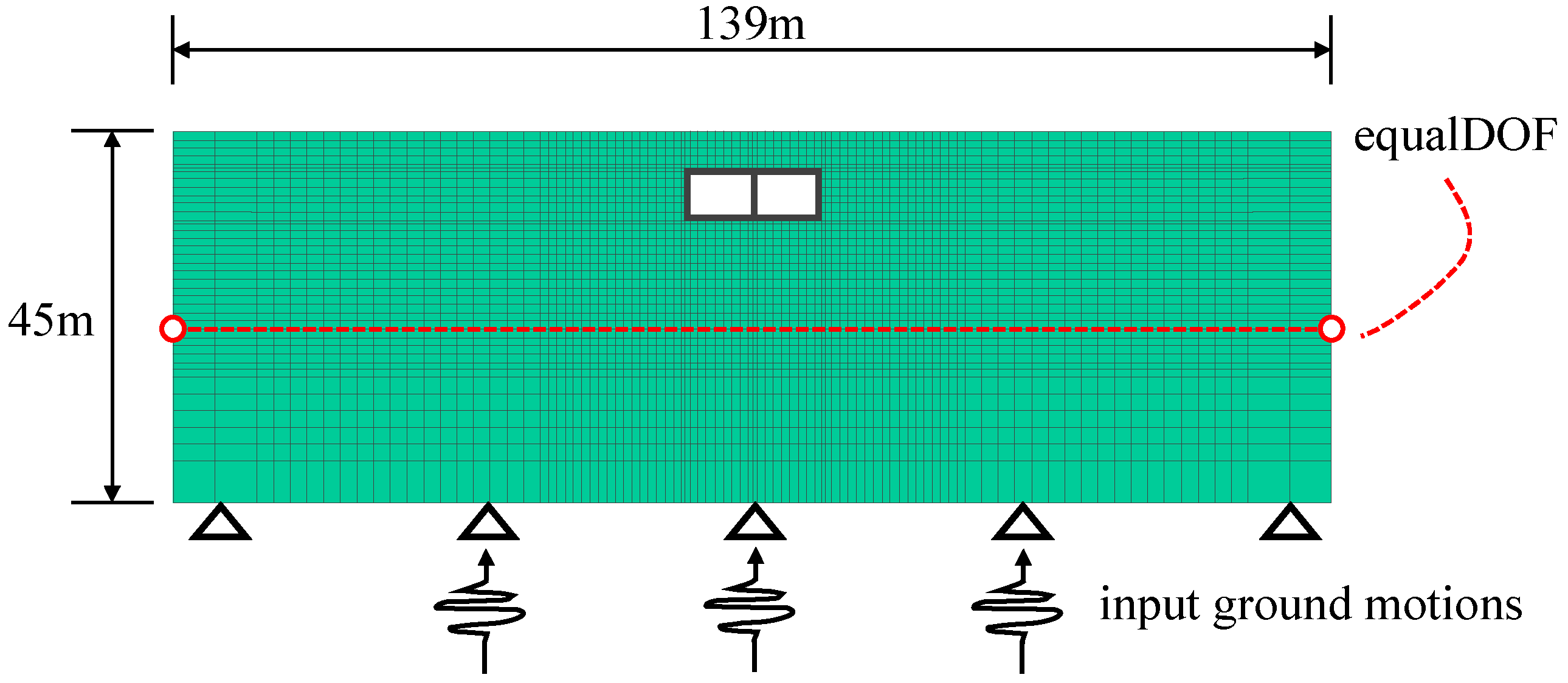
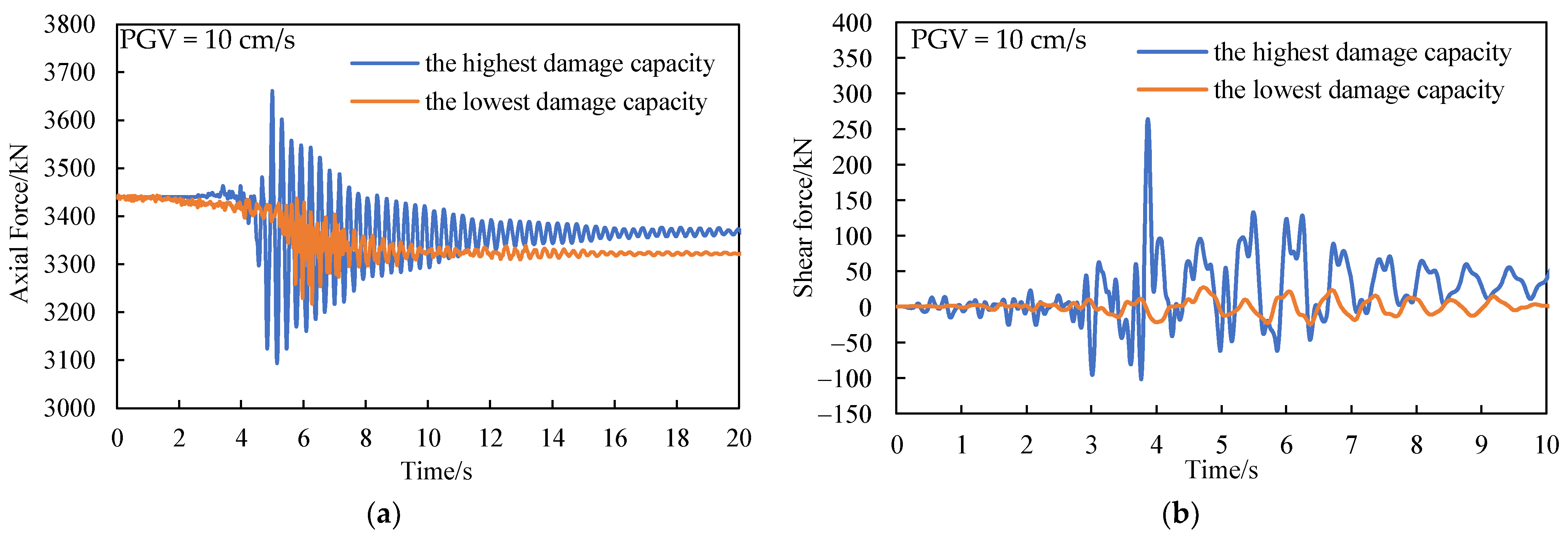


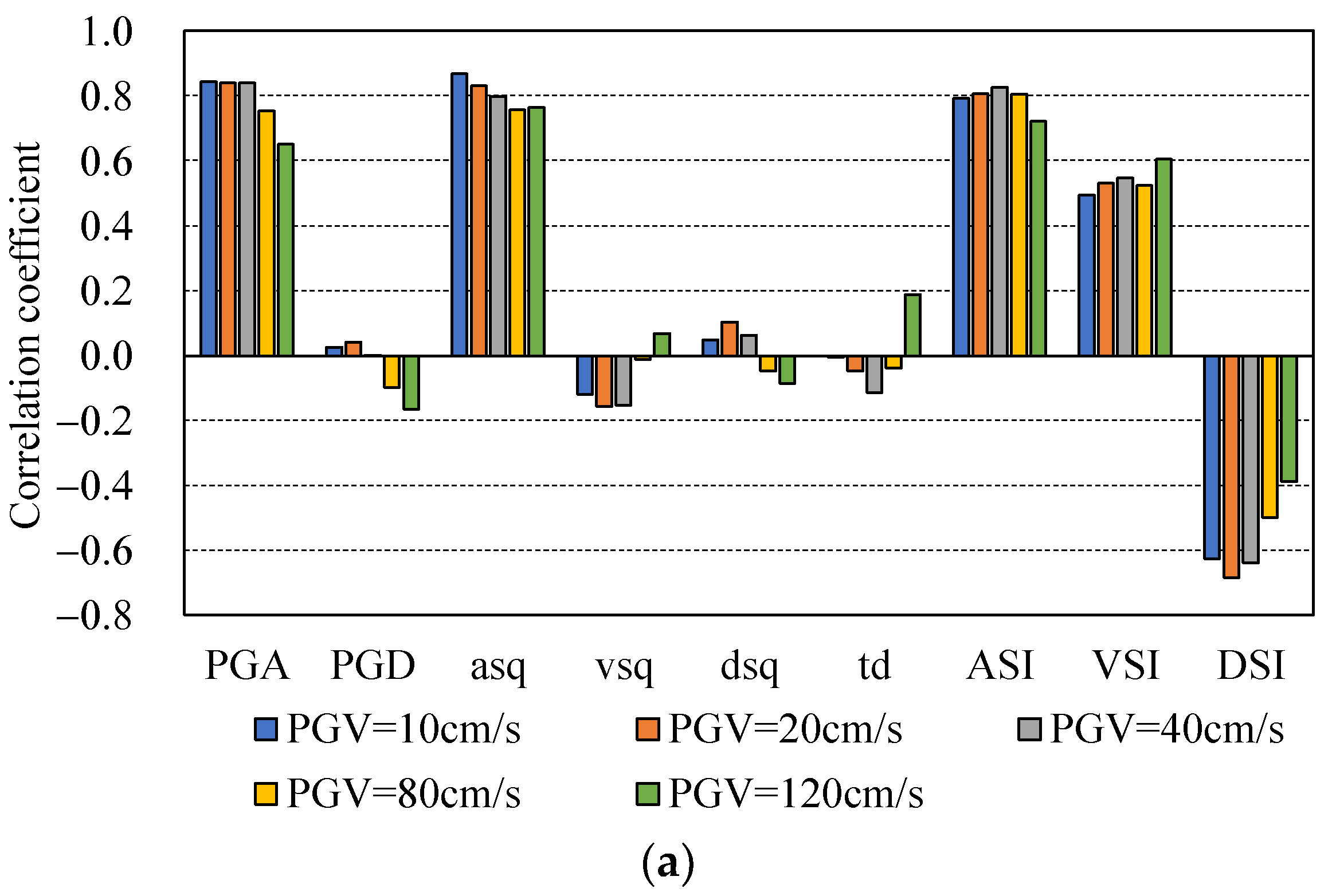
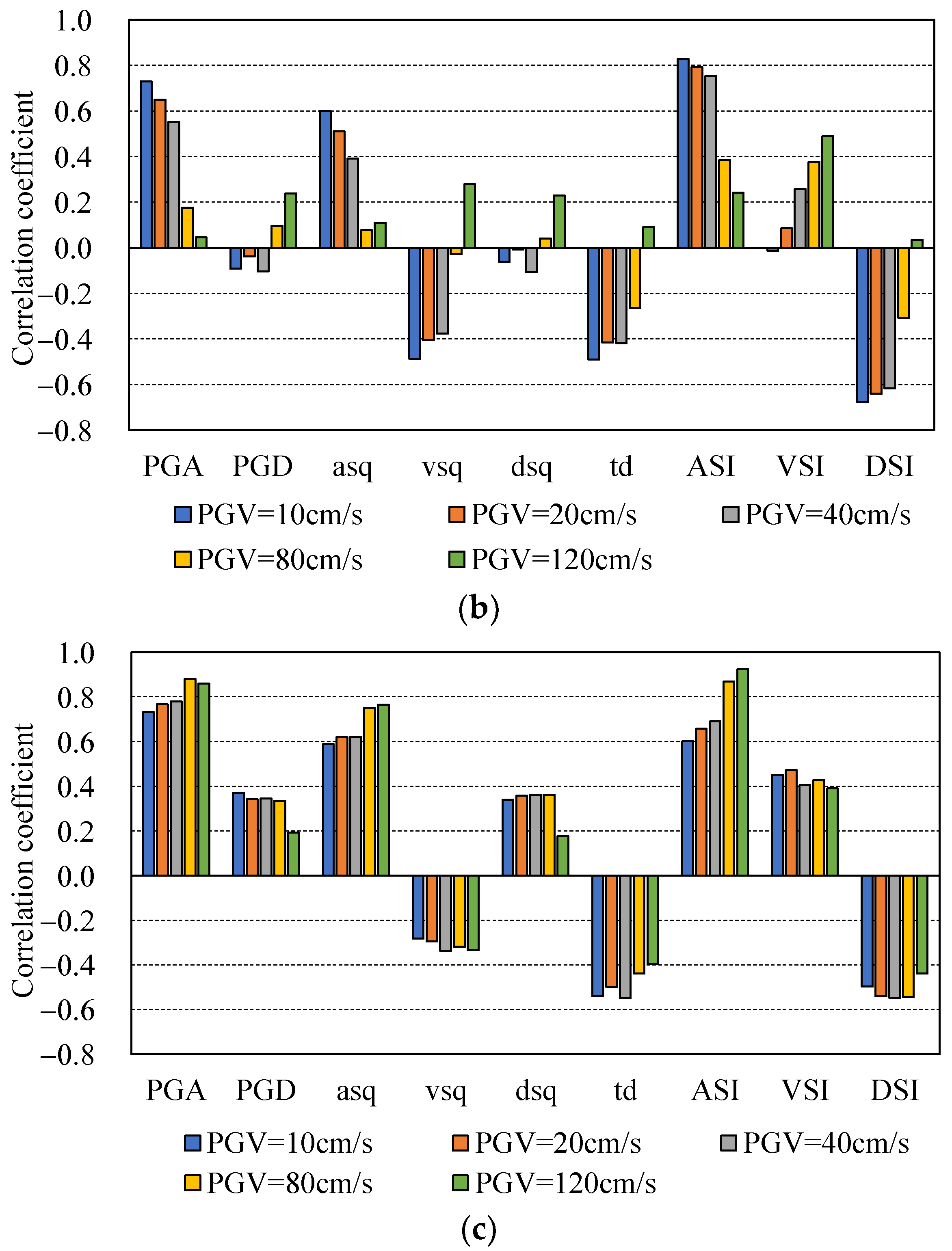

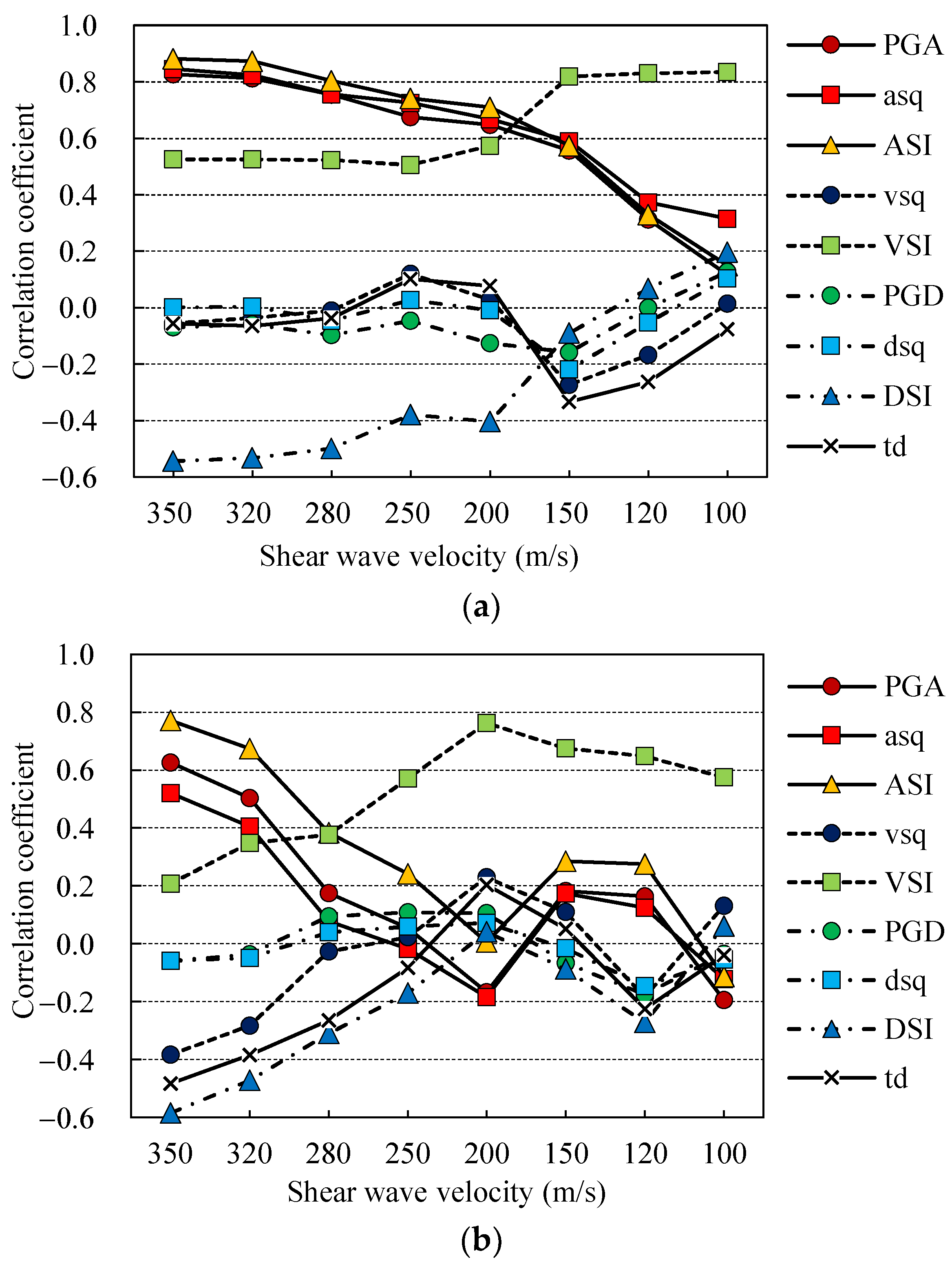
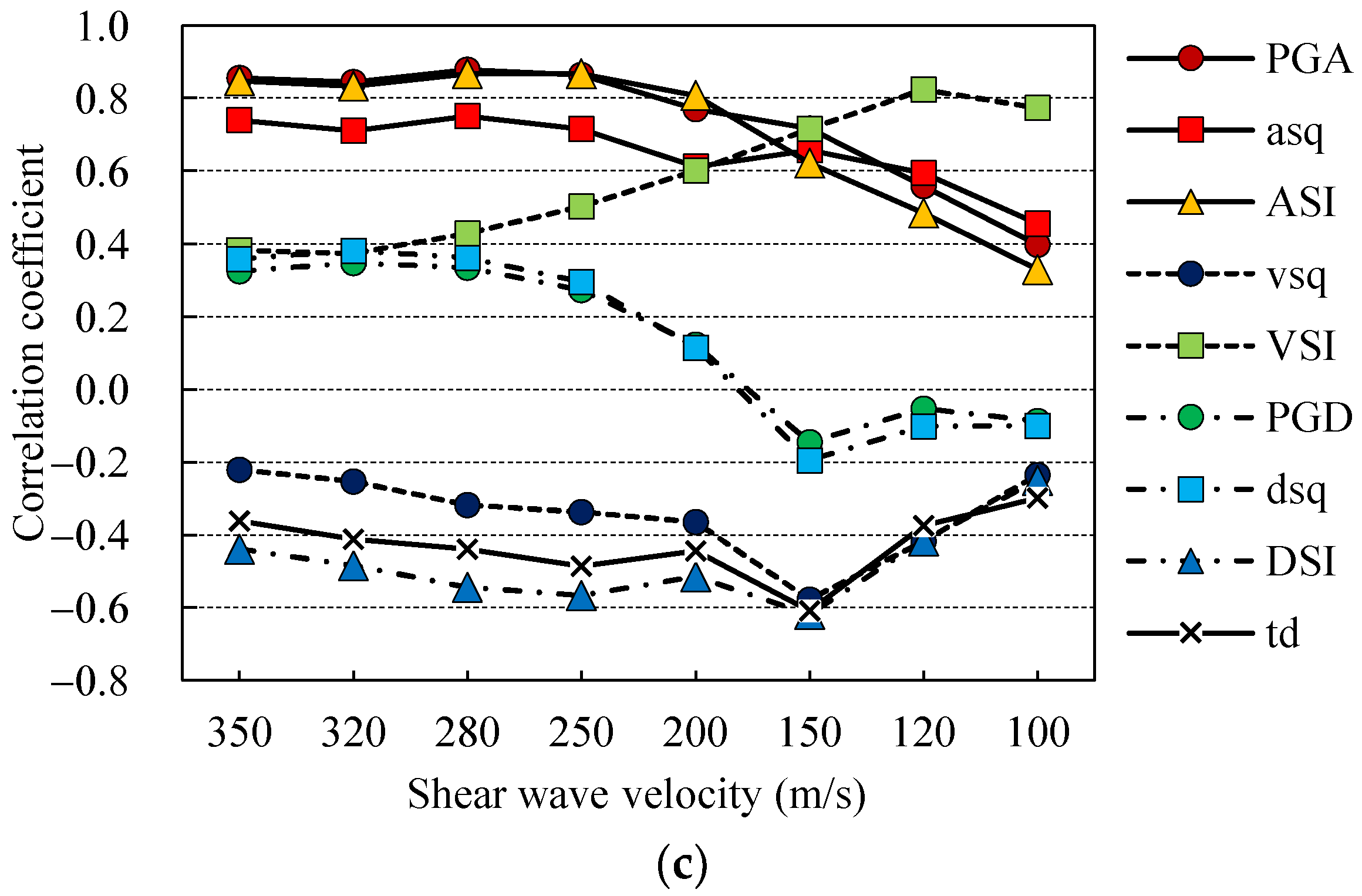

| Material | Reinforcement | Concrete |
|---|---|---|
| Density, ρ/(kg/m−3) | 7800 | 2500 |
| Elastic modulus, E/GPa | 200 | 30 |
| strain-hardening ratio, α | 0.00001 | — |
| Yield stress, fy/MPa | 235 | — |
| Axial compressive strength fc0/MPa | — | 23.52 (the central column) 20.58 (others) |
| Ultimate compressive strength, fu/MPa | — | 12.2 |
| Peak compressive strain, εc0 | — | 0.0028 |
| Ultimate compressive strain, εu | — | 0.004 |
| Site Category | Class II Sites | Class III Sites |
|---|---|---|
| Shear wave velocity, Vs20/(m/s) | 350/320/280/250/200 | 150/120/100 |
| Density, ρ/(kg/m3) | 1900 | 1800 |
| Initial shear modulus, G/MPa | 233/195/149/119/76 | 40.5/25.9/18 |
| Poisson’s ratio, μ | 0.35 | 0.40 |
| Cohesion, c/kPa | 37.0 | 18.0 |
| friction angle, φ/° | 30.0 | 20.0 |
| Name | Formulation | Name | Formulation | Name | Formulation | |
|---|---|---|---|---|---|---|
| Acceleration-related | PGA | asq | ASI | |||
| velocity-related | vsq | VSI | ||||
| displacement-related | PGD | dsq | DSI | |||
| Others | td | t95-t5 |
Disclaimer/Publisher’s Note: The statements, opinions and data contained in all publications are solely those of the individual author(s) and contributor(s) and not of MDPI and/or the editor(s). MDPI and/or the editor(s) disclaim responsibility for any injury to people or property resulting from any ideas, methods, instructions or products referred to in the content. |
© 2024 by the authors. Licensee MDPI, Basel, Switzerland. This article is an open access article distributed under the terms and conditions of the Creative Commons Attribution (CC BY) license (https://creativecommons.org/licenses/by/4.0/).
Share and Cite
Li, Y.; Wei, H. Methods of Assessing the Damage Capacity of Input Seismic Motions for Underground Structures. Buildings 2024, 14, 996. https://doi.org/10.3390/buildings14040996
Li Y, Wei H. Methods of Assessing the Damage Capacity of Input Seismic Motions for Underground Structures. Buildings. 2024; 14(4):996. https://doi.org/10.3390/buildings14040996
Chicago/Turabian StyleLi, Yilin, and Hanlin Wei. 2024. "Methods of Assessing the Damage Capacity of Input Seismic Motions for Underground Structures" Buildings 14, no. 4: 996. https://doi.org/10.3390/buildings14040996
APA StyleLi, Y., & Wei, H. (2024). Methods of Assessing the Damage Capacity of Input Seismic Motions for Underground Structures. Buildings, 14(4), 996. https://doi.org/10.3390/buildings14040996





